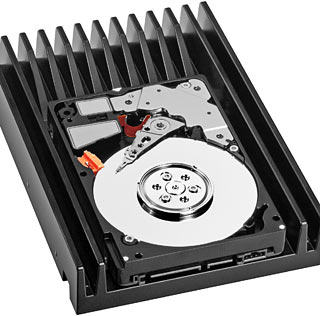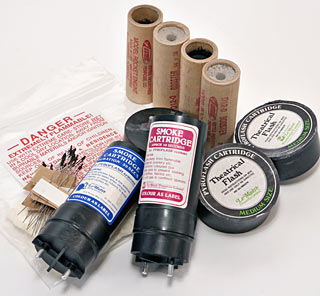
Atomic I/O letters column #120
Originally published 2011, in Atomic: Maximum Power ComputingReprinted here August 19, 2011 Last modified 16-Jan-2015.
More drives! More video cards!
I currently have a moderate gaming system: Core i5 750 (OC'd), 4GB RAM (OC'd), ATI 5770 (OC'd) and a RAID 0 boot setup (2 x 1TB 7,200). It's the RAID I have a question about.
With standard mechanical HDDs being so cheap and SSDs still currently not available for most users (speed vs price + size), could I upgrade my RAID 0 using 2 x 1TB to a 4 x 1Tb and receive worthwhile speed benefits (along with lots more space that I need) for booting into Windows 7, using general applications and gaming? I don't like looking at loading screens!
I know I don't have to re-install from scratch if I make an image (I've done that already going from non-RAID to RAID 0) and I also have other external HDDs for backing up important files. If there is no real performance benefit I could just purchase a single 2TB HDD instead. I've done some research (via search engines) and there are mixed results with lots of people saying not to do it due to risk of data loss.
Mainboard: Asus P7P55D-E PRO Current RAID HDDs: 2 x Samsung 1TB Spinpoint F3 SATA II 7200RPM 32M
On a side note, I was thinking of upgrading my 5770 to 2 x 5770 to just before Dragon Age II is here [this letters column ran six months ago in Atomic magazine], as I am using a 1900 x 1200 screen and I'd like to turn all visuals to maximum settings. Any thoughts on whether I should, or instead purchase a single faster graphics card?
Fabian

The Western Digital VelociRaptor. How are the mighty fallen.
Answer:
RAID 0 is not a great idea for an everyday computer's boot device.
This is because RAID 0 isn't really RAID, a Redundant Array of Independent (or Inexpensive, depending on who you ask) Disks (or Drives) at all. It's not "redundant", but rather stripes data across however many drives you have in the "stripeset". If any drive in an n-drive RAID 0 set dies, you lose every nth block of data, and the whole stripeset becomes unrecoverable. RAID 0 is even worse than JBOD, "Just a Bunch of Disks", which joins drives end-to-end.
RAID 0's limitations are OK for applications where you need lots of capacity and as much speed as possible, and lower reliability isn't a big problem. Video editing, some kinds of scientific computing - short-term caching of large datasets, in general. But to make RAID 0 a really good idea in even those situations, you need a fast RAID controller, which I presume you don't have, since you mention your motherboard but not an add-on controller board.
The RAID controllers on consumer motherboards have always been of the "fake-RAID" type, where the actual controller hardware does barely more than a non-RAID controller can do, and all of the algorithmic heavy lifting for striping and mirroring and, for RAID-5-capable fake-RAID controllers, parity calculation, is done by a software driver.
Fake-hardware-RAID is pretty robust these days, provided you can get a driver for your OS (Windows? Yes. Linux? Maybe). But it still doesn't give you performance much better than that of pure software RAID - what you get if you set up a RAID set in your operating system (in "Disk Management", for Windows), not in the RAID controller's own config utility.
Nowadays, CPUs are so fast that software or fake-hardware-RAID is acceptable for many applications that used to require a "proper" hardware RAID controller. But then again, consumer hard drives nowadays are so large and so fast, at least as far as sustained transfer rate goes, that many tasks that used to require RAID no longer require it at all.
The system performance hit of any kind of software RAID calculation used to be significant enough that software RAID or fake-hardware-RAID was only really useful for data protection (using some RAID level other than 0...) or making space for huge datasets that needed one big single "drive". That performance hit is now also negligible, but you still shouldn't expect a very impressive difference in everyday system performance from even a four-drive RAID 0 stripeset driven by an expensive 3ware controller card, let alone fake-hardware-RAID or software RAID.
And, again, if you're sticking with RAID 0, then if any drive fails your whole boot device dies. Even if you have a recent whole-drive-image backup which you can easily restore onto a new boot device (this may be less than straightforward, if you're trying to image a fake-RAID stripeset...), the death of your boot device will still substantially reduce your enjoyment of that day. If, like most people, you don't have a full and fairly recent boot-device backup, then you'll be reinstalling everything from the OS up.
It's perfectly possible that any given shiny new model of hard drive will turn out to have a 5% first-year failure rate. Most drives do rather better than this, but it's impossible to tell how robust any given model of drive is until it's obsolete.
With a 5% chance of failure, a four-drive RAID-0 boot device is not a fantastic bet. Four chained 95%-chance-of-survival probabilities give a total survival chance of 81.5% (not, as you might think, 80%).
At the moment, an SSD for a boot drive plus one or more big magnetic drives for bulk data (including large applications) is the clear value winner, if you want a snappy system. Before Flash-RAM SSDs were consumer-market products, high-speed magnetic drives like 15,000RPM SCSI devices and Western Digital's 10,000RPM VelociRaptor SATA drives served the same function.
The fastest spinning disks cut down seek speed as well as rotational latency by using small-diameter platters (VelociRaptors are essentially a souped-up 2.5-inch laptop drive bolted onto a 3.5-inch heat sink), so even a VelociRaptor with its "mere" 10kRPM rotational speed gives a clear improvement in system responsiveness compared with a normal 7200RPM drive.
But nowadays this isn't a hugely attractive option, unless you need both moderately high speed and moderately high capacity for a more-than-moderately high price. As I write this, a 600Gb VelociRaptor will set you back a bit more than $AU300 delivered. That amount of money will only buy you about a 128Gb SSD, but it's enough for five or six formatted terabytes of "1.5Tb" or "2Tb" drives.
If I were you, I'd carry on with my current RAIDed boot drive with my fingers crossed and save up for an SSD, or just buy a single new 7200RPM drive, image the current boot device onto it and make it C:, then format the two 1Tb units and use them as data drives. If you don't mind halving their capacity, mirror them onto each other (RAID 1) for an underwhelming speed improvement and doubled, instead of halved, reliability. Note that Windows will not necessarily inform you when drives in a RAID 1 array fail.
(I might also, if I were you, save an eBay search for Gigabyte i-RAMs, just in case anybody in the world ever sells one of those with 4Gb of RAM on it for a price not profoundly influenced by inexpensive freebase cocaine. Sticking 4Gb of swap on a RAM disk won't actually do a vast amount for system performance, but it's more fun, and more reliable, than booting from a 4-drive RAID 0!)
With regard to doubling up your graphics cards to show proper obeisance to Dragon Age II:
THIS STATEMENT NOT APPROVED BY ATOMIC MAGAZINE'S MAJOR ADVERTISERS: Never upgrade your graphics card before you get a new game.
Well, don't do it unless you, for some reason (like, you're a scientist at an Antarctic base, and it's winter), are unable to get a new graphics card any time you like.
Get the game. Play the game. Determine whether the frame rate at acceptable prettiness-settings is good enough. Check to see whether the upgrade you're considering actually makes a significant difference, according to sagacious magazine reviewers and teenage early-adopters on Web forums.
An exception can be made in the particular case when you're upgrading to something that's already more than a year old, and therefore clearly stone-knives-and-bearskins technology, if the age of the hardware means you can get a new card very cheaply.
AMD/ATI encourage this with their heterogeneous multi-card possibilities, that let you CrossFire together any combination of 5700-series cards, or any combination of 5800-series cards, et cetera. If you can get an HD 5750 for $20, whatever performance improvement it gives you will probably be very good value.
If you're buying a new 5770 off the shelf for more than $AU150, though, the dollars-per-FPS ratio is likely to strongly favour, once again, saving up for a single newer product (perhaps a Radeon HD69x0 or GeForce GTX 560 Ti), rather than strapping older products together.
1: Buy live crickets. 2: Fill victim's PC.
Software practical jokes are boring. Setting stupid system sounds, making the desktop a screenshot of itself, that sudden screaming skull thing.
I want my computer April Fools stuff to have more meat.
What kind of HARDWARE practical jokes are there? Computer-specific stuff, not just putting Vegemite in a DVD drive instead of on the windscreen wipers.
(It's a shame that PSUs don't have that "110/220" switch on the back any more, isn't it?)
Adam

All of this stuff lights from 12 volts.
Your move, creep.
Answer:
There are many possibilities. And, just as some jokers are happy to add Vegemite to wipers and door-handles while
other jokers prefer filling the entire car with two-part foam,
some jolly PC japes also demonstrate more... commitment to the celebration... than others.
You could, for instance, carefully collect the dust bunnies from the entire office's computers and lovingly transfer them to a single recipient.
Or help keep your target safe from electrocution by adding insulation to the dangerous contacts on things like USB plugs, audio connectors or, for advanced jokers, whole expansion cards.
Sticky tape can do this job, but clear nail polish is sturdier and harder to detect.
(Note that if you cover all but the little x1 portion of a PCIe x16 graphics card's connector with tape or varnish, there's a good chance the card will still work, but be strangely slow.)
The sturdy 12V power rails in PCs that make it so easy to light up a computer case also allow you to run all sorts of other 12V gear. Like, say, the traditional "Taiwanese National Anthem" Six Tone Car Alarm Siren. (Get one with a backup battery, so it'll keep screaming even when the PC's hastily turned off, or indeed when the siren's been torn bodily from the case!)
A little coil of nichrome wire sitting in a teacup full of water-based glycol smoke fluid will let your target settle in for a while, before his PC apparently catches fire.
If you're impatient, though, note that model-rocket "electric match" igniters will also work just fine from a PC's 12V!
And never mind April Fools - it's always the right time for an Etherkiller!

